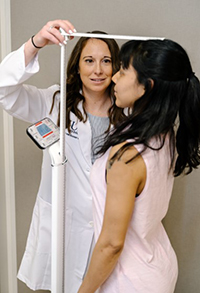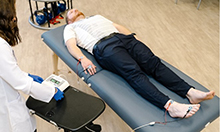Body Composition Assessment
Basic body composition can be expressed as the relative percentage of body mass that is fat and fat-free tissue. It is well established that excess body fat, particularly when located centrally around the abdomen, is associated with hypertension, metabolic syndrome, type 2 diabetes, stroke, coronary artery disease, and hyperlipidemia. The PEAK Human Performance Science Clinical Research Lab offers several methods of assessing anthropometry and body composition.
Anthropometry
 Height and body weight are measured using a calibrated scale. Body Mass Index (BMI) is used to assess body weight relative to height and can be calculated by dividing body weight in kilograms by height in meters squared. The measurement of regional body circumference is important as an indicator of body fat distribution. We have a supply of Gulick Tape Measures and protocols for accurate assessments of waist circumference, hip circumference, and a wide variety of additional anthropometric locations.
Height and body weight are measured using a calibrated scale. Body Mass Index (BMI) is used to assess body weight relative to height and can be calculated by dividing body weight in kilograms by height in meters squared. The measurement of regional body circumference is important as an indicator of body fat distribution. We have a supply of Gulick Tape Measures and protocols for accurate assessments of waist circumference, hip circumference, and a wide variety of additional anthropometric locations.
Bioelectric Impedance (BIA)

The RJL bioelectric impedance analysis system is available to assess the body composition outcomes (e.g., reactance, resistance, total body water, intracellular water, extracellular water, fat mass, lean mass, and skeletal muscle mass).
Skinfold Measurements
The Skinfold technique is a body composition method that estimates body fat composition by determining the thickness of several folds of skin across the body. Skinfold assessments are measured with Harpenden or Lange skinfold calipers.

